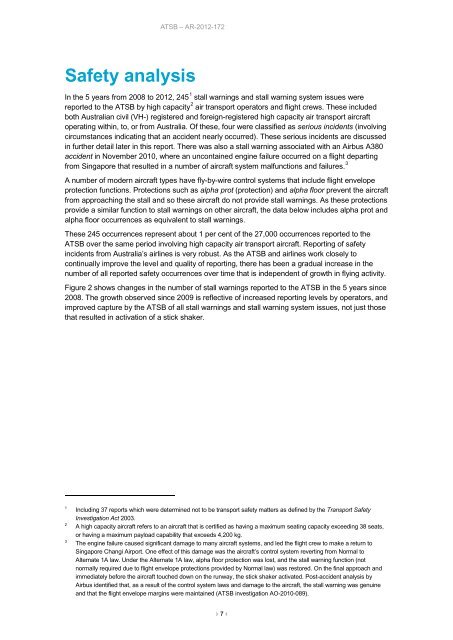Stall warnings in high capacity aircraft: The Australian context 2008 ...
Stall warnings in high capacity aircraft: The Australian context 2008 ...
Stall warnings in high capacity aircraft: The Australian context 2008 ...
Create successful ePaper yourself
Turn your PDF publications into a flip-book with our unique Google optimized e-Paper software.
ATSB – AR-2012-172<br />
Safety analysis<br />
In the 5 years from <strong>2008</strong> to 2012, 245 1 stall <strong>warn<strong>in</strong>gs</strong> and stall warn<strong>in</strong>g system issues were<br />
reported to the ATSB by <strong>high</strong> <strong>capacity</strong> 2 air transport operators and flight crews. <strong>The</strong>se <strong>in</strong>cluded<br />
both <strong>Australian</strong> civil (VH-) registered and foreign-registered <strong>high</strong> <strong>capacity</strong> air transport <strong>aircraft</strong><br />
operat<strong>in</strong>g with<strong>in</strong>, to, or from Australia. Of these, four were classified as serious <strong>in</strong>cidents (<strong>in</strong>volv<strong>in</strong>g<br />
circumstances <strong>in</strong>dicat<strong>in</strong>g that an accident nearly occurred). <strong>The</strong>se serious <strong>in</strong>cidents are discussed<br />
<strong>in</strong> further detail later <strong>in</strong> this report. <strong>The</strong>re was also a stall warn<strong>in</strong>g associated with an Airbus A380<br />
accident <strong>in</strong> November 2010, where an unconta<strong>in</strong>ed eng<strong>in</strong>e failure occurred on a flight depart<strong>in</strong>g<br />
from S<strong>in</strong>gapore that resulted <strong>in</strong> a number of <strong>aircraft</strong> system malfunctions and failures. 3<br />
A number of modern <strong>aircraft</strong> types have fly-by-wire control systems that <strong>in</strong>clude flight envelope<br />
protection functions. Protections such as alpha prot (protection) and alpha floor prevent the <strong>aircraft</strong><br />
from approach<strong>in</strong>g the stall and so these <strong>aircraft</strong> do not provide stall <strong>warn<strong>in</strong>gs</strong>. As these protections<br />
provide a similar function to stall <strong>warn<strong>in</strong>gs</strong> on other <strong>aircraft</strong>, the data below <strong>in</strong>cludes alpha prot and<br />
alpha floor occurrences as equivalent to stall <strong>warn<strong>in</strong>gs</strong>.<br />
<strong>The</strong>se 245 occurrences represent about 1 per cent of the 27,000 occurrences reported to the<br />
ATSB over the same period <strong>in</strong>volv<strong>in</strong>g <strong>high</strong> <strong>capacity</strong> air transport <strong>aircraft</strong>. Report<strong>in</strong>g of safety<br />
<strong>in</strong>cidents from Australia’s airl<strong>in</strong>es is very robust. As the ATSB and airl<strong>in</strong>es work closely to<br />
cont<strong>in</strong>ually improve the level and quality of report<strong>in</strong>g, there has been a gradual <strong>in</strong>crease <strong>in</strong> the<br />
number of all reported safety occurrences over time that is <strong>in</strong>dependent of growth <strong>in</strong> fly<strong>in</strong>g activity.<br />
Figure 2 shows changes <strong>in</strong> the number of stall <strong>warn<strong>in</strong>gs</strong> reported to the ATSB <strong>in</strong> the 5 years s<strong>in</strong>ce<br />
<strong>2008</strong>. <strong>The</strong> growth observed s<strong>in</strong>ce 2009 is reflective of <strong>in</strong>creased report<strong>in</strong>g levels by operators, and<br />
improved capture by the ATSB of all stall <strong>warn<strong>in</strong>gs</strong> and stall warn<strong>in</strong>g system issues, not just those<br />
that resulted <strong>in</strong> activation of a stick shaker.<br />
1<br />
2<br />
3<br />
Includ<strong>in</strong>g 37 reports which were determ<strong>in</strong>ed not to be transport safety matters as def<strong>in</strong>ed by the Transport Safety<br />
Investigation Act 2003.<br />
A <strong>high</strong> <strong>capacity</strong> <strong>aircraft</strong> refers to an <strong>aircraft</strong> that is certified as hav<strong>in</strong>g a maximum seat<strong>in</strong>g <strong>capacity</strong> exceed<strong>in</strong>g 38 seats,<br />
or hav<strong>in</strong>g a maximum payload capability that exceeds 4,200 kg.<br />
<strong>The</strong> eng<strong>in</strong>e failure caused significant damage to many <strong>aircraft</strong> systems, and led the flight crew to make a return to<br />
S<strong>in</strong>gapore Changi Airport. One effect of this damage was the <strong>aircraft</strong>’s control system revert<strong>in</strong>g from Normal to<br />
Alternate 1A law. Under the Alternate 1A law, alpha floor protection was lost, and the stall warn<strong>in</strong>g function (not<br />
normally required due to flight envelope protections provided by Normal law) was restored. On the f<strong>in</strong>al approach and<br />
immediately before the <strong>aircraft</strong> touched down on the runway, the stick shaker activated. Post-accident analysis by<br />
Airbus identified that, as a result of the control system laws and damage to the <strong>aircraft</strong>, the stall warn<strong>in</strong>g was genu<strong>in</strong>e<br />
and that the flight envelope marg<strong>in</strong>s were ma<strong>in</strong>ta<strong>in</strong>ed (ATSB <strong>in</strong>vestigation AO-2010-089).<br />
› 7 ‹
















